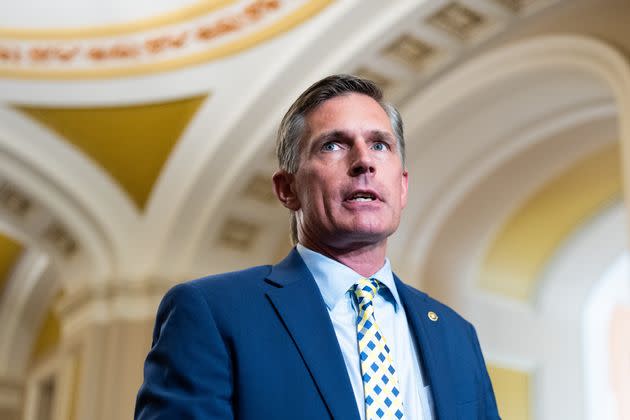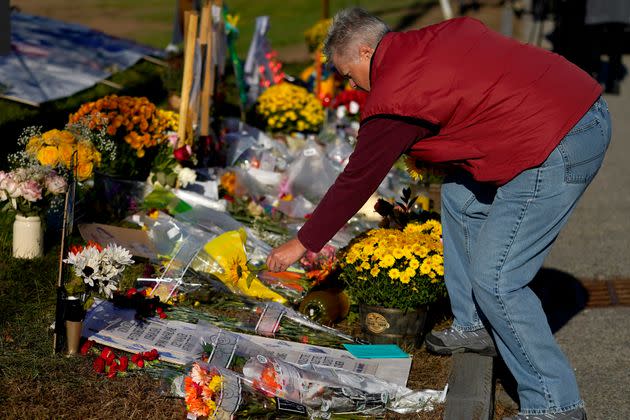This Senator Has A New Idea To Curb Mass Shootings — And Gun Reformers Are Actually Optimistic
Semi-automatic rifles with detachable magazines would face broad new restrictions under a proposal unveiled Tuesday by a group of Democratic senators.
The “GOSAFE Act,”introduced by Sen. Martin Heinrich (D-N.M.), aims to limit easy access to high-powered rifles that can fire dozens of rounds with blazing speed. But unlike the long-stalled assault weapons ban, the new bill regulates the internal mechanisms of firearms, leading to a simpler proposed law that reflects a more sophisticated understanding of how firearms work.
Heinrich, an engineer and lifelong gun owner, started crafting the legislative proposal back in 2017, after a gunman sprayed more than 1,000 rounds into the Route 91 Harvest festival in Las Vegas, leaving 60 people dead and more than 400 people injured. He described the law as a practical way of limiting the lethality of the semi-automatic rifles typically used in mass shootings, while respecting the rights of responsible firearm owners.
“As lawmakers, we should be able to draw a line between traditional firearms used for hunting, sport and self-defense, and these weapons of war designed to take human life,” Heinrich said at a press conference.

Sen. Martin Heinrich (D-N.M.) introduced a new bill in the Senate that would regulate semi-automatic rifles based on their internal firing mechanisms.
Under the proposed law, new gas-operated semi-automatic rifles could only be sold if they feature a fixed magazine capable of holding no more than 10 cartridges. People who own existing semi-automatic rifles with detachable magazines would be able to keep them, transfer them to family members, or allow the government to buy them back.
The bill would also ban bump stocks, which harness recoil to boost the rate of fire to a level mimicking a fully automatic weapon.
The United States has seen some 630 mass shootings in which four or more people were shot or killed so far this year, according to the Gun Violence Archive, a nonpartisan tracker — a rate approaching two per day.
By narrowly focusing on the reloading mechanism, the bill aims to limit semi-automatic rifles’ rate of fire, slowing shooters’ ability to inflict casualties and giving first responders space to take advantage of their need to slowly feed more cartridges into a smaller fixed magazine.
“Let’s face it, I’ve shot many of these weapons,” Heinrich said. “I focused on those mechanics, rather than on cosmetic features that individuals or even manufacturers can quickly modify.”
In one of the bill’s most novel features, gun manufacturers would have to submit all new rifle designs to the Bureau of Alcohol, Tobacco, Firearms and Explosives to confirm that they comply with the law’s terms.
The proposed law would only apply to semi-automatic rifles. Specific exemptions exclude bolt-action, single-shot and rimfire rifles, as well as autoloading shotguns, and recoil-operated pistols — including those with large-capacity magazines.

A community member places flowers at a memorial in Lewiston, Maine, on Nov. 3. Eighteen people were killed there in a mass shooting, the deadliest in the state's history.
Sen. Mark Kelly (D-Ariz.), a co-sponsor of the bill, noted that the mass shooter who attacked his wife, former U.S. Rep. Gabby Giffords, in 2011 was only attacked and disarmed while attempting to reload a semi-automatic pistol with an extended magazine.
Handguns would not fall under the regulations of the proposed GOSAFE Act, but Kelly said limiting the rate of fire and forcing would-be mass shooters to reload more frequently and slowly would save lives.
“Regulating these weapons and magazines — it’s just common sense, and it’s the thing that’s going to help with these mass shootings,” Kelly said. “Our country has experienced mass shooting after mass shooting. It’s time that we start looking at fresh approaches.”
The proposal addresses longstanding criticisms of the assault weapons ban from firearm enthusiasts and the gun lobby.
The term “assault weapon” is vague and hard to describe for legal purposes. Members of Congress and several state legislatures have confronted the problem by barring guns by model name, along with specifying prohibited cosmetic features, like pistol grips, folding stocks and threaded barrels.
The result is a complex and lengthy proposal whose current draft stretches to 126 pages — five times longer than the GOSAFE Act.
Gun reformers applauded the new approach, hoping that it has the potential to attract bipartisan support.
“It’s a new approach to saving lives,” said Monisha Henley, senior vice president of government affairs for Everytown for Gun Safety. “It’s really targeting the deadly speed, the rate of fire — which is how so many people can be killed as a result of these weapons.”
Reformers have struggled to convince Congress to restrict semi-automatic rifles since the Assault Weapons Ban of 1994 expired almost 20 years ago.
Senate Majority Leader Chuck Schumer (D-N.Y.) announced Monday that he planned to bring the a proposal to reinstate the assault weapons ban to the floor for a vote this week. It’s unlikely, however, that he has the 50 votes needed to pass it into law, let alone the 60 votes needed to open debate on it under the chamber’s rules.
Democrats, who tend to favor gun reform, barely hold a majority in the Senate. Republicans, who generally champion sweeping Second Amendment protections, control the House of Representatives.
It remains to be seen whether Heinrich can succeed in currying more support for federal reform.
The proposal would immediately face legal challenges if it were to become law. The National Shooting Sports Foundation, the firearms trade group, noted that the Supreme Court ruled in District of Columbia v. Heller back in 2008 that the federal government could not ban entire classes of firearms.
“The legislation introduced by Senators [Angus] King and Heinrich is openly defiant of the rights protected by the U.S. Constitution,” NSSF’s general counsel, Lawrence Keane, wrote in a press release. “There is no path forward for legislation of this nature that would deprive law-abiding citizens the ability to lawfully possess the firearm of their choosing and the full spectrum of their Second Amendment rights.”

